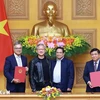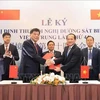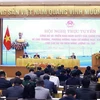Vietnam should improve the infrastructure of logistics, management of supply chains and commercial procedures to increase the competitiveness of its exports in the world market, said HSBC.
According to the HSBC Research Department's report on Vietnam's macro economy, Vietnam is now a net exporter of food and a price setter for many agricultural commodities in the global market, ranging from rice to coffee. Even in manufacturing, it is gaining a global market share, with the label Made in Vietnam being increasingly visible in shopping malls across the world.
The report was released by the HSBC Bank (Vietnam) Ltd.
Vietnam has become one of the world's most trade-oriented economies, with its exports comprising 77 percent of the GDP in 2013, up from 46 percent in 2001. This is all thanks to the trade liberalisation process since the early 1990s, which has helped remove barriers, both tariff and non-tariff.
The country's exports growth is expected to increase by double digits per year by 2025, with free-trade agreements expected between Vietnam and other trade partners in the world in the future, including the TPP and the free-trade agreement with the EU.
Vietnam is competitive in agriculture and labour-intensive manufacturing, mainly because its population is still predominantly rural. Trade liberalisation efforts such as the TPP and EU-FTA will help facilitate exports and investment by taking advantage of the increased market access. With the wind in their sails, more Vietnamese goods are expected to be shipped across the globe. But the speed at which exports can accelerate is limited, as Vietnam's economic engine is still firing on only two cylinders: labour and land.
Vietnam's current strategy of depending on its natural resources and labour force is not sustainable. Resources have diminishing returns and wages inevitably rise. The major exports are still dominated by raw materials and low-value-added manufactured goods. Thus, the real game-changer for Vietnam's export competitiveness is tackling the enemies within: poor logistics infrastructure, supply chain management and trade procedures.
"The ongoing improvements in transport corridors, customs procedures, manufacturing and agricultural supply chains will allow Vietnam to upgrade the quality of its processed agricultural products and manufactured goods, making them much more competitive in the global markets," HSBC said.
Whether it's broken rice, Robusta coffee, crude oil, textiles or electronic handsets, Vietnamese exports are stuck at the lower end of the value chain, according to the report. Agriculture products are primarily in raw rather than processed form, forcing farmers to compete over volumes. Manufactured goods are mostly labour intensive, with limited local inputs.
Cumbersome transport logistics, trade procedures and an inefficient supply chain organisation are the main reasons for Vietnam being stuck in low gear. With a working population growth rate that is expected to decline in two decades and agriculture yields likely to diminish over time, not to mention the increasing competition in the region, the prevailing strategy is not sustainable in the long term. Therefore, Vietnam is making preparations for its economy to move up the value chain.-VNA
According to the HSBC Research Department's report on Vietnam's macro economy, Vietnam is now a net exporter of food and a price setter for many agricultural commodities in the global market, ranging from rice to coffee. Even in manufacturing, it is gaining a global market share, with the label Made in Vietnam being increasingly visible in shopping malls across the world.
The report was released by the HSBC Bank (Vietnam) Ltd.
Vietnam has become one of the world's most trade-oriented economies, with its exports comprising 77 percent of the GDP in 2013, up from 46 percent in 2001. This is all thanks to the trade liberalisation process since the early 1990s, which has helped remove barriers, both tariff and non-tariff.
The country's exports growth is expected to increase by double digits per year by 2025, with free-trade agreements expected between Vietnam and other trade partners in the world in the future, including the TPP and the free-trade agreement with the EU.
Vietnam is competitive in agriculture and labour-intensive manufacturing, mainly because its population is still predominantly rural. Trade liberalisation efforts such as the TPP and EU-FTA will help facilitate exports and investment by taking advantage of the increased market access. With the wind in their sails, more Vietnamese goods are expected to be shipped across the globe. But the speed at which exports can accelerate is limited, as Vietnam's economic engine is still firing on only two cylinders: labour and land.
Vietnam's current strategy of depending on its natural resources and labour force is not sustainable. Resources have diminishing returns and wages inevitably rise. The major exports are still dominated by raw materials and low-value-added manufactured goods. Thus, the real game-changer for Vietnam's export competitiveness is tackling the enemies within: poor logistics infrastructure, supply chain management and trade procedures.
"The ongoing improvements in transport corridors, customs procedures, manufacturing and agricultural supply chains will allow Vietnam to upgrade the quality of its processed agricultural products and manufactured goods, making them much more competitive in the global markets," HSBC said.
Whether it's broken rice, Robusta coffee, crude oil, textiles or electronic handsets, Vietnamese exports are stuck at the lower end of the value chain, according to the report. Agriculture products are primarily in raw rather than processed form, forcing farmers to compete over volumes. Manufactured goods are mostly labour intensive, with limited local inputs.
Cumbersome transport logistics, trade procedures and an inefficient supply chain organisation are the main reasons for Vietnam being stuck in low gear. With a working population growth rate that is expected to decline in two decades and agriculture yields likely to diminish over time, not to mention the increasing competition in the region, the prevailing strategy is not sustainable in the long term. Therefore, Vietnam is making preparations for its economy to move up the value chain.-VNA



















